 |
||
|
||
| ||
TABLE OF CONTENTSIt's well known that ASUSTeK is the oldest manufacturer of not only motherboards (the company started its business with them), but also of video cards. The company has had its ups and downs in this sector. Interestingly, as soon as the company hears criticism that its video card department goofs off and just manufactures reference cards or even buys them from other manufacturers, it announces very interesting products short time afterwards. So we should always criticize ASUSTeK so that it worked well and fruitfully :). When there started talks about SLI solutions on a single PCB instead of two stand-alone cards, there appeared a lot of skeptics concerning rationality of this approach. Firstly, PCB should be cardinally redesigned, as two sets of GPU+Memory chips must be placed on a compact board (PC cases cannot be enlarged at request). Secondly, NVIDIA drivers enable SLI only on proper motherboards anyway. So two GPUs on a single card or two single-GPU cards - you still must have a motherboard on nForce4 SLI or any other chipset with SLI support. Such a monster will still require a motherboard with two PCI-E x16 slots. Is there a reason to buy a dual-processor accelerator, when you can just install two cards in a SLI mode? That's why when accelerators with two GeForce 6600GT GPUs on board only started to appear (the very first editions), there were a lot of doubts concerning expediency of such production. It will be in demand only when the total price of two separate cards will be much higher than a dual-GPU card based on the same processors. But nevertheless, the first Gigabyte 3D1 (2x6600GT) cards were bought very fast, even though the price of this card was close to the total sum of two 6600GT cards. Of course, Leadtek and ASUS wanted the same fame, as their Taiwanese neighbour. But they delayed the launch of such cards for too long, so that it became inexpedient. ASUS and Gigabyte almost simultaneously announced more powerful products, this time based on GeForce 6800 GT. But while Gigabyte really overhauled the PCB and placed two sets of GPU+Memory chips compactly (half of them are even at the back of the board), resulting in an accelerator that can be installed nearly to any modern spacious PC case; ASUS took a simple road: it just merged two PCBs from GeForce 6800 GT and got an airfield-sized card. It can be installed into very few PC cases, but it also has other drawbacks, like noisy operation. Two coolers on a similar product from Gigabyte are no less noisy, though. When I was describing all the drawbacks (obviously in the majority) of the above-mentioned products, I was thinking why the company wasted millions of dollars on R&D and production for a limited edition of a couple of hundred of such cards for media resources. Well, and perhaps a hundred of cards for fans of exotic hardware and collectors. Some expenses will return in the form of increased interest to the company and its brand (advertisement expenses). But it still seems to me that it's sort of an experiment to streamline future dual-GPU solutions. My forecasts came partially true. A new product from ASUS is launched nearly in time (it had better be done right after the announcement of single-processor cards with the same GPU) - a dual-processor card, based on GeForce 7800 GT. Before we proceed to examining the new product, I want to tell you that many drawbacks of the previous solution were rectified in this card. Most importantly, the PCB dimensions are reduced and all memory chips are left on the front side of the board to facilitate cooling.
Here is a short video (WMV, 16MB) about the new product.
Video card
Comparison with a single GeForce 7800GT is just nominal, its PCB is totally different. Note that in the first edition of a dual-processor card (Dual 6800GT) ASUS just merged two cards on a single PCB, having arranged them diagonally, to make room for a common power supply unit. As a result, the company got a huge card, which doesn't fit into the majority of PC cases. Besides, it contained a lot of empty space (irrational layout). This product was obviously designed in a great hurry, without a well thought-out and more expensive approach to rationalizing the layout, keeping the operation stability at given frequencies.
In case of Dual 7800GT, lots of mistakes have been corrected. Firstly, the huge dimensions of the previous generation were reduced as far as possible: all elements on the PCB are arranged more compactly, the length of the card does not exceed that of the well-known 3dfx Voodoo5 5500
It's still longer than GeForce 7800 GTX 256/512MB, but not that critically as Dual 6800GT. Secondly, all the chips are placed on the front side for better cooling. That is designers managed to combine compact dimensions with this condition (unlike Gigabyte Dual 6800GT, for example). The product is equipped with two DVI jacks (of course, Dual-Link), it supports VIVO. The card may come shipped with optional cables with two d-Sub connectors, which can be easily mounted into special holes on a bracket, the PCB itself have connectors for these cables. As a result, we get a video card that can output to four monitors. Of course, when SLI is enabled, the card outputs only to a single monitor.
The card offers another important property - increased operating frequencies relative to the nominal value: 430/1200 MHz versus 400/1000 MHz. Besides, the card is equipped with 1.6ns memory chips instead of 2.0ns ones, as we are accustomed to see on regular GeForce 7800GT cards. Of course, it gives you a right to hope for faster 3D performance compared a regular SLI GeForce 7800GT (made up of two cards).
Here is the bundle. In fact it offers nothing new, a standard set of accessories (cables and discs) (plus a bonus - a stylish CD case). The games are old, but after mid November the bundles of production-line cards will include Call Of Duty2. We should note that the card comes shipped with its own power supply.
The box is traditionally large. But the design is modified, there appeared a new character on a dark gray background. An evil one again (when will sorcerers and monsters be gone from the boxes of high-performance products?!).
Installation and DriversTestbed configurations:
As I have already mentioned above, the cooling system is very efficient - the core temperature did not reach 78°C even under the heaviest load at standard frequencies. If we take 2000 rpm for 25% of the fan load, the peak rotational speed for 50% is 4000 rpm. There is still almost no noise.


And now about overclocking. As you can see from the monitoring graph, the card managed to operate at 486/1360 MHz. The card overclocks well (considering the 400/1000 MHz nominal)! It should be noted that the cooling system ensures stable operation even at these frequencies. The card didn't even get hotter!
Test results: performance comparisonWe used the following test applications:
Game tests that heavily load vertex shaders, mixed pixel shaders 1.1 and 2.0, active multitexturing.FarCry, Research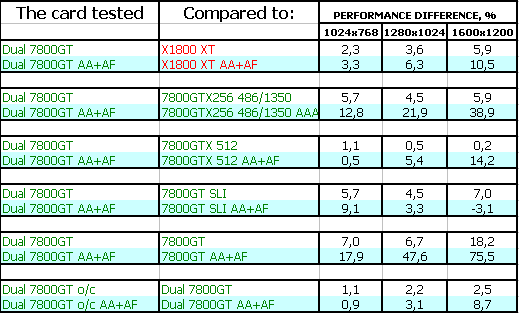
Considering that this game is relatively easy for modern accelerators even with АА+АF (you have to enable heavier АА modes and HDR, but it will complicate comparison of video cards), the difference percents are very low. Nevertheless, the card under review takes up the lead and outperforms GeForce 7800 GTX 512MB. It would have been strange otherwise. SLI gain is also impressive. Game tests that heavily load vertex shaders, pixel shaders 2.0, active multitexturing.F.E.A.R. v.1.01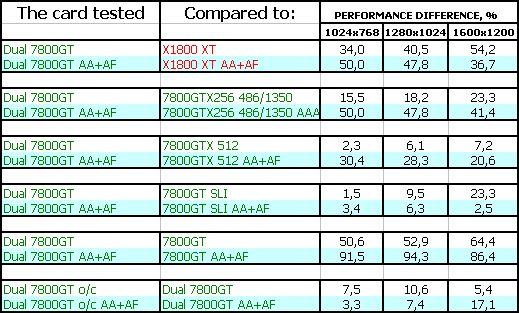
This situation is similar, the only difference is that the advantage percentage of Dual 7800GT is higher in this test. We can see that even GeForce 7800 GTX 512MB is slower by more than 20%. Of course, the product from ASUS will be more expensive, but its benefits are also good. Especially considering that many new games will be as heavy in 3D as this one. Splinter Cell Chaos Theory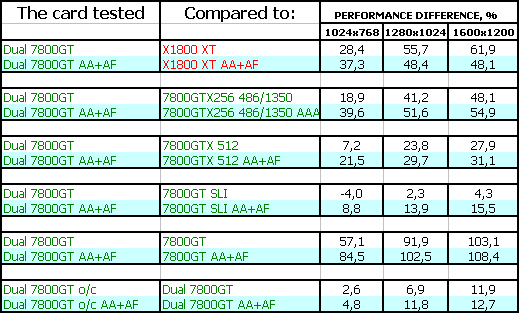
The situation is similar. We can just note that the gain over a single GeForce 7800GT exceeds 100% here. That's a normal situation, considering that Dual 7800GT operates at increased frequencies.
Call Of Duty 2 DEMO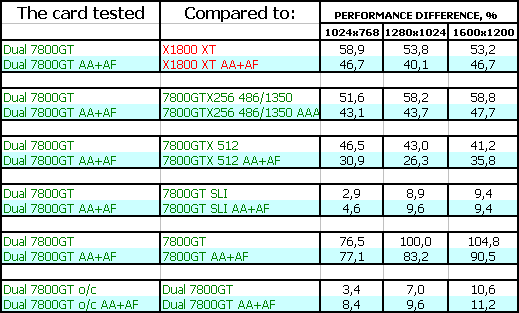
I think no comments are necessary here, the same picture here. The product from ASUS shows some advantage over 7800GT SLI, which can be explained by its higher frequencies. Does it fit the price difference between two 7800GT cards and Dual 7800GT? It's a difficult question. I think no, if we consider 3D performance only. Half-Life2: ixbt01 demoTest results: Half-Life2, ixbt01 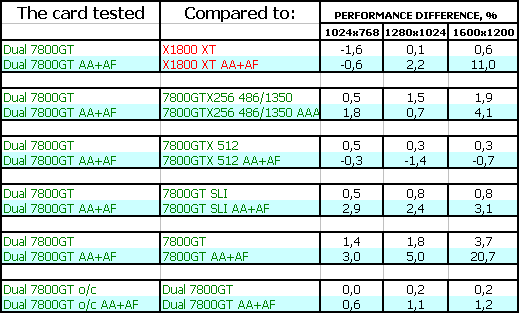
In this case, like in Far Cry, the game has become relatively easy for powerful accelerators. Even АА+АF cannot help to get rid of the dependence on CPU and system resources. That's why the performance difference percentage is low. But our conclusions are the same: Dual 7800GT is the leader here.
Game tests that heavily load pixel pipelines with texturing, active operations of the stencil buffer and shader unitsDOOM III High mode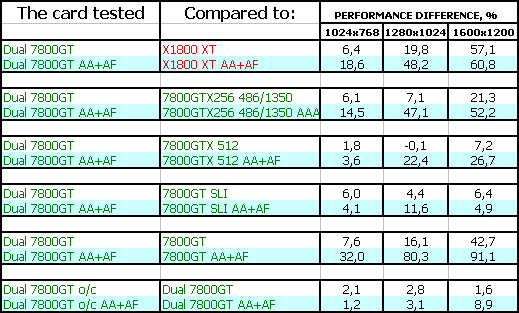
Chronicles of Riddick, demo 44

If we don't take into account traditionally high results of all NVIDIA cards in these tests and spare banal words about ASUS Dual 7800GT leadership, we can note that the increased frequencies yielded good dividends compared to 7800GT SLI. It's important, considering that the absolute speed is not super high.
Synthetic tests that heavily load shader units3DMark05: MARKS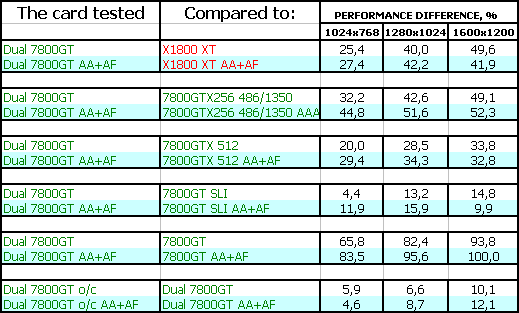
Everything must be like in mathematics in this test: concise and according to the rules. And it really is: all the rates correspond to cards' characteristics, all the gains are adequate. ASUS Dual 7800GT takes up the lead. But don't forget that the largest gain over competitors (except for a single 7800GT) does not exceed 55-60%, that is approximately 1.5-fold. But the price is more than 1.5 times as high. And now we proceed to our conclusions. ConclusionsASUS Extreme Dual N7800GT 512MB is the most powerful accelerator on a single PCB from ASUS, if we can say so. Indeed, there are no faster products so far. I repeat, ON A SINGLE PCB. By the way, can we install two such cards on an nForce4 X16 motherboard? Theoretically we can. Besides, NVIDIA promises to allow four GPUs to work together. Getting back to the card itself, we can say that it's a collector's piece. Yep, just about 2000 cards will be manufactured. Hence the price. That's a point concerning too high a price, if we take into account only card's advantages in 3D. This product will come officially at about $850, but the initial price may even reach $1000. It's clear that two GeForce 7800GT cards, even at increased frequencies (from Leadtek or Gainward) are more expedient. But let's not forget that, first of all, this cooler is quiet, much quieter than in two cards. Secondly, the card has its own external power supply unit, so it does not have serious requirements to a PSU that can be demanded by two GeForce 7800GT cards. There are some disadvantages, of course. Quite a large PCB, mandatory SLI support in your motherboard. Well, we can also add that the card does not blow the hot air out of the PC case. ASUS might have cooperated with Arctic Cooling and design a cooling system, based on this famous cooler. But still, it's a collector's piece! No matter how we blame coins for their imprints, they will be welcome in any collection, if they are rare and well done. I think that there are more than 2000 enthusiasts of 3D, so the entire edition will be bought instantaneously. This is a very well thought-out product for a narrow niche. You can find more detailed comparisons of various video cards in our 3Digest.
ASUS Extreme Dual N7800GT 512MB PCI-E gets the Original Design award (November).
 Theoretical materials and reviews of video cards, which concern functional properties of the GPU ATI RADEON X1800 (R520)/X1600 (RV530)/X1300 (RV515) and NVIDIA GeForce 6800 (NV40/45)/7800 (G70)/6600 (NV43)Write a comment below. No registration needed!
|
Platform · Video · Multimedia · Mobile · Other || About us & Privacy policy · Twitter · Facebook Copyright © Byrds Research & Publishing, Ltd., 1997–2011. All rights reserved. | ||||||||||||||||||||||||||||||||||||||||||||||||||||||||